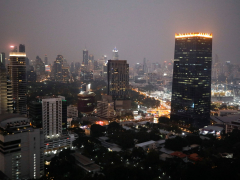Bangkok, Thailand – In the teeming metropolis that is central Bangkok, Methinee Phoovatis monitored a small computer screen, hoping to find signs of survivors.
Surrounding Methinee, other members of Thailand’s Department of Disaster Prevention and Mitigation (DDPM) coordinated the dozens of rescue workers shuttling along a path that led to an enormous mound of debris.
The rescue teams worked in shifts, searching for any indications of life under the hill of cement and steel that loomed over them.
“We are just hoping for a miracle that some of the people are still alive,” Methinee, a plan and policy analyst in the DDPM, told Al Jazeera.
It was four days after a magnitude 7.7 earthquake jolted Bangkok on March 28, and as the hours and days passed, the chances of Methinee and her colleagues finding survivors were increasingly slim.
“We are trying our best for the people. Hopefully, they are still alive,” she said, standing next to a whiteboard showing the tally of 73 people that were still missing under the rubble of the unfinished 30-storey building, which was designed to house Thailand’s National Audit Office.
The earthquake that rocked the Thai capital was particularly shallow, just 10km (6.2 miles) deep, which intensified the shock waves on the earth’s surface.
Though situated more than 1,200km (750 miles) from the epicentre in Myanmar where thousands died, the earthquake brought Bangkok to a standstill. Panicked residents of this city of more than 11 million people rushed out into the streets in search of safety as buildings swayed and shuddered.
A month on, life in the Thai capital has returned to normal.
But the dozens of deaths – most of which were at the site of the collapsed audit office building – and the shock of the events of March 28 have prompted concerns for some in Bangkok about the safety of high-rise living in the world’s 12th tallest city.

‘People were screaming’
A sudden feeling of nausea and the swaying of lamps inside his apartment on the ninth floor of a 41-storey building told Harry Yang he was in danger.
“I ran out onto my balcony and everything was shaking,” said the 29-year-old, who has called Bangkok his home since birth.
“People were screaming,” he said.
Dashing down the fire escape stairs, Yang immediately thought of his ageing father who lives on the 32nd floor in another high-rise building in Bangkok and who has issues with mobility.
Although his father, who works as an antique dealer, made it out of the ordeal unscathed, the quake destroyed many of his antiques and left him terrified.
“My dad is 68 years old, he has leg problems, and he needed to climb down” stairs to reach the ground floor, Yang said.
People had good reason to be scared. Video clips on social media showed Bangkok shaking, with debris falling to the ground and water pouring in torrents from skyscraper infinity swimming pools.
Lapaphutch Lertsachanant was in her condominium on the 27th floor when the quake struck.
“The building was literally moving side to side. I really felt at that moment that the building could be cut in half,” Lapaphutch said.
“I really thought that I wouldn’t survive,” she added, recalling her desire to speak to her partner one final time by phone. “I thought I could have my last words with him. He would be with me in my last moments alive.”
Although seismic events in the wider Southeast Asia region are common, the scale of the quake that hit Myanmar – where more than 3,700 people were killed – and shook Bangkok took many by surprise.
Wang Yu, associate professor in the department of geosciences at the National Taiwan University, said Myanmar lies directly on a tectonic fault line, the Sagaing Fault, and the March 28 quake occurred after a strike-slip fault between the India and Eurasian plates.
According to the United States Geological Survey (USGS), a strike-slip refers to a tectonic fault where two plates move horizontally past each other. Since 1900, the USGS reports that six other large earthquakes with a magnitude of 7.0 or more have occurred within 250km (155 miles) of the epicentre in Myanmar of the March 28 quake.
Bangkok is built on a basin of unstable soil that can increase the effect of these quakes, Wang Yu explained.
“When a seismic wave transmits from the outside into the basin, the amplitude of the seismic wave will be enlarged,” he said.
But the precise reason why the building in central Bangkok collapsed remains under investigation. No other building in Bangkok suffered such a catastrophic failure, although many sustained structural damage. Officials in Thailand have launched an investigation to assess whether proper building protocols were followed.
![Bangkok Earthquake Collapse Site 2-1745574216 [Jan Camenzind Broomby/Al Jazeera]](http://www.aljazeera.com/wp-content/uploads/2025/04/Bangkok-Earthquake-Collapse-Site-2-1745574216.png?w=770&resize=770%2C513&quality=80)





